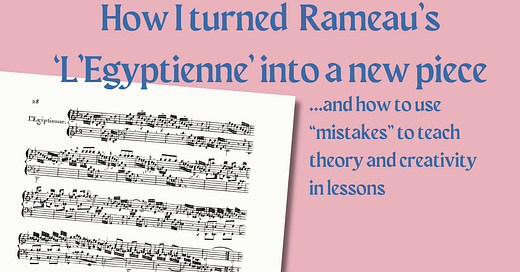Creativity occurs in unexpected places, you just need to keep an eye out for it.
Mistakes can be inspiring
When I was first learning Rameau’s ‘L’Egyptienne’, I practised the opening gesture, a cross hands broken chord of G minor, over and over. It works really well as an exercise because it is so easily repeated.
Sometimes I found myself hitting a wrong note that sounded interesting — I particularly enjoyed it when I hit an E instead of a D, or an F instead of a G.
Sometimes I enjoyed the wrong notes so much that I started doing them deliberately, and this gradually evolved into an improvisation concept:
Start “right”, then become increasingly “wrong”
Using “mistakes” for creativity
If your student makes an interesting mistake in the lesson, it’s an opportunity!
You could explain why the mistake doesn’t sound good, which is a great opportunity to talk about harmony.
This could then lead to an improvisation that explores the “mistake”. I often do this, and it looks like this:
explain what they did “wrong”
explain why it sounds interesting (usually because it puts us into another scale)
explore what the rest of the piece would sound like if we kept making the same mistake (e.g. change all the Bs into B♭s)
Students learn a great deal through this kind of investigative play. I highly recommend it!
I call this new piece ‘L’Egyptienne (Cascades)’
I’ve since recorded this and it will be released on Piano & Coffee Records this Friday. Here’s the version we’re releasing:
Instructions
If you wanted to try this yourself, here’s the overall schema:
Repeat the opening G minor pattern of the original piece several times, playing it slowly and with pedal
At some point, play a "wrong note", e.g. F, A, E♭, or E, then incorporate this into the pattern
Continue adding "wrong notes" until the chord has fully changed
Repeat
This is a relatively advanced piece (RCM have it as a Level 9 piece.) If you wanted something simpler, look for any simple chordal
piece that you know well.
Thanks to The Thinking Pianist
The video at the top of the post was recorded by David Jones at The Thinking Pianist 2023, as part of the final concert recital. Here’s the full video, including my performance of the original piece by Rameau.
Thanks very much to David and to Cheltenham Ladies College for allowing me to use this video. If you’ve not already read my rave review of their course, it’s below!
The Thinking Pianist: the highlight of my year
This post diverges from my usual focus on creativity, but with good reason: next July, I think you should come to The Thinking Pianist summer residential course.
















Share this post